 Because of its size being similar to the commonly known rats, the water vole is often referred to as water rat, with its tail comprising 2/3 of its body length; its auricles barely protrude through the fur. It is widespread in the region and is multitudinous in places. Water voles are semiaquatic. They are good swimmers and divers, settling in the banks of the rivers, lakes and creaks overgrown by bush and grasses. Besides, they inhabit wet parts of forests, particularly the ones with overgrowing ditches, backwaters and ponds. The animal is active in twilight and at night. It lives in holes in the banks or in the nests it builds under willow bushes or in tussocks. The water vole forages on aquatic and marginal vegetation (sedges, cattails, bulrush, horsetails, arrowheads etc.) It also eats bark, shrub shoots, insects, mollusks, leeches etc. The species builds forage stocks. Often it inhabits acceptable spots in human settlements. Here, it would damage fruiters, vegetable and grain crops. Presence of water voles in populated areas is fraught with infections passing from natural foci to people and domesticated species, since water voles are the main vehicle of tularemia, leptospirosis etc.
Because of its size being similar to the commonly known rats, the water vole is often referred to as water rat, with its tail comprising 2/3 of its body length; its auricles barely protrude through the fur. It is widespread in the region and is multitudinous in places. Water voles are semiaquatic. They are good swimmers and divers, settling in the banks of the rivers, lakes and creaks overgrown by bush and grasses. Besides, they inhabit wet parts of forests, particularly the ones with overgrowing ditches, backwaters and ponds. The animal is active in twilight and at night. It lives in holes in the banks or in the nests it builds under willow bushes or in tussocks. The water vole forages on aquatic and marginal vegetation (sedges, cattails, bulrush, horsetails, arrowheads etc.) It also eats bark, shrub shoots, insects, mollusks, leeches etc. The species builds forage stocks. Often it inhabits acceptable spots in human settlements. Here, it would damage fruiters, vegetable and grain crops. Presence of water voles in populated areas is fraught with infections passing from natural foci to people and domesticated species, since water voles are the main vehicle of tularemia, leptospirosis etc.
/ * The photos at lake.peipsi.org are cross-posted from commons.wikimedia.org and are used for familiarization purposes only. No commercial use of the photos is allowed. For more information about to use the photos see the originals on commons.wikimedia.org. /


